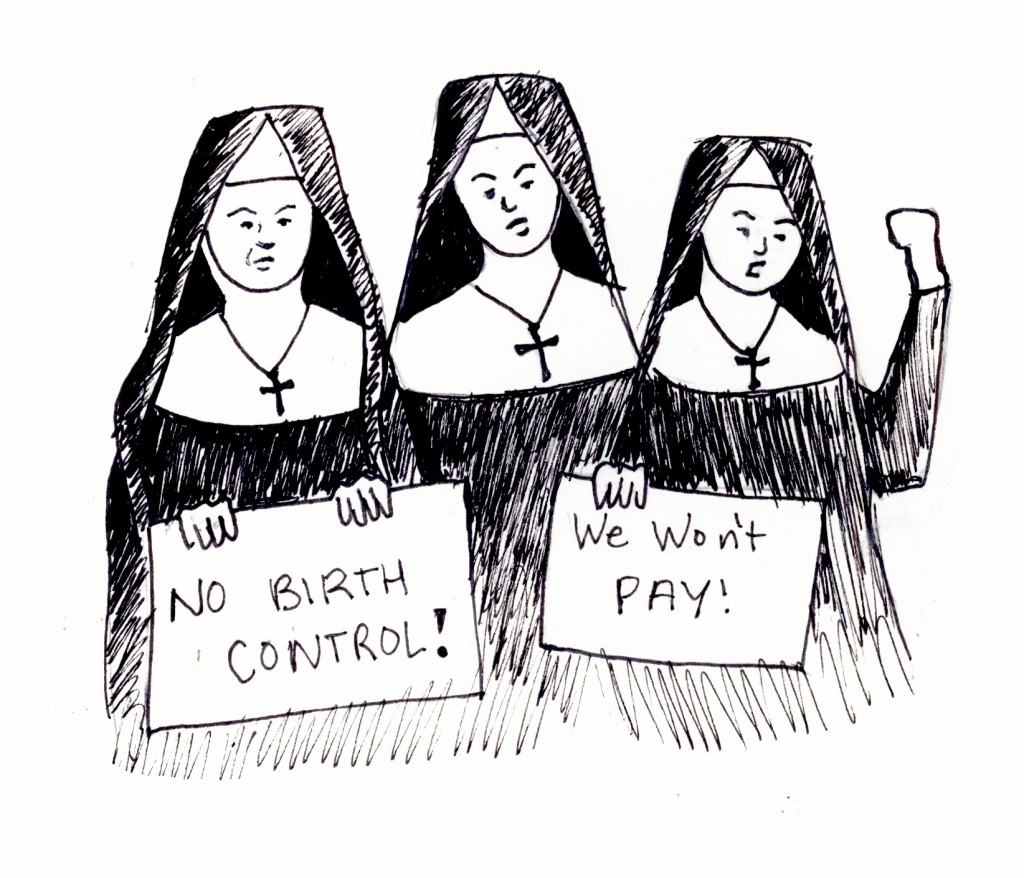Hello readers! I hope that, despite Punxsutawney Phil’s prediction of six more weeks of winter, you’re keeping warm and reading up on Supreme Court news. I’m here this week to discuss a subject that is near and dear to my heart: women’s reproductive health. Two events took place at the Supreme Court in January that hold significance for the women’s reproductive rights movement, and there is more discord on the horizon, as the Supreme Court hears Sebelius v. Hobby Lobby Stores, Inc. and Conestoga Wood Specialties Corp. v. Sebelius in March. (For my preview of those cases, see here.)
The first issue arose right as 2013 became 2014, when Justice Sonia Sotomayor “temporarily blocked the Obama administration from forcing some religiously affiliated groups to provide health insurance coverage of birth control or face penalties as part of the Affordable Care Act” (from the New York Times). The “contraception mandate” of the Affordable Care Act dictates that all employers must provide their employees with health care insurance coverage for contraception, which includes birth control pills. A group of nuns in Colorado filed an order requesting that the contraception mandate be stayed by a court so that the nuns’ religiously affiliated group, the Little Sisters of the Poor Home for the Aged, would not have to violate its religious beliefs and provide contraception coverage to its employees (from the New York Times).
The new “Obamacare” health care system was set to go into effect on January 1, so Justice Sotomayor’s response to the nuns’ order was filed late on New Year’s Eve in order to block the law from taking effect. Specifically, “Sotomayor blocked the government from enforcing the requirement on the Denver [senior care] home until further notice from the Supreme Court” (from Politico), and her block of the mandate applies only to Little Sisters of the Poor Home for the Aged and the “more than 200 other faith-based groups that use insurance offered by the Christian Brothers Employee Benefit Trust” (from the Washington Post). As such, her stay of the mandate is not nationwide. It is important to note, though, that “most nonprofit groups that challenged the mandate ha[ve] received temporary reprieves” (from the Washington Post), indicating a larger anti-contraception-mandate trend.
Depending on how the Court rules in Sebelius v. Hobby Lobby Stores, Inc. and Conestoga Wood Specialties Corp. v. Sebelius, it just might happen that religious affiliations across the country will be freed from the so-called burden of the contraceptive mandate. (For another preview of those cases that explains the religious aspect well, read these two articles from the Washington Post.) Hobby Lobby and Conestoga both have outcomes that are wider-reaching than just the “Obamacare contraceptive mandate”—if decided a certain way, each case would grant corporations the same religious freedoms granted to American citizens under the First Amendment—but Sotomayor’s decision to side with the Denver nuns on New Year’s Eve and stay the contraception mandate for their religiously affiliated business is telling. She is considered to be a more “liberal” member of the nine-justice Supreme Court, yet she decided to deny contraceptive coverage to employees of a business based on that business’s religious affiliation. What conclusions will the other eight justices draw? We’ll be closer to an answer on March 25, when both cases are argued in front of the Court. Until then, I’m going to have stress dreams about the “corporations have religious rights” argument, and I will keep my eyes peeled for any further developments with the contraception mandate.
Two weeks after Sotomayor’s stay on the contraceptive mandate, the Supreme Court heard oral arguments for McCullen v. Coakley. At stake in this case is “Massachusetts’ selective exclusion law,” a law relating to women’s reproductive health clinics “which makes it a crime for speakers other than clinic ‘employees or agents… acting within the scope of their employment’ to ‘enter or remain on a public way or sidewalk’ within thirty-five feet of an entrance, exit, or driveway of ‘a reproductive health care facility’” (from SCOTUSblog). The Massachusetts state legislature created this “buffer zone” law in 2007, and the law was upheld in both a district court and the U.S. Court of Appeals for the First Circuit (from Oyez).
The district court ruled that, “although the law placed a restriction on the time, place, and manner of speech, the law was constitutional because it was content-neutral and still left adequate, if not perfect, alternative means of communications.” The First Circuit agreed with this reasoning, but also held that “the Supreme Court, in Hill v. Colorado, had already affirmed a similar statute in Colorado that prohibited certain activities within 100 feet of abortion clinics” (from Oyez). As such, the Supreme Court will also discuss whether Hill v. Colorado allows for the enforcement of Massachusetts’ buffer zone law, and whether that case should be limited or overruled.
 At first glance, it might not seem that this case about “buffer zones” and a Supreme Court decision from 2000 are directly related to issues of women’s reproductive health. The law, though, was instated in Massachusetts because of the extremity of the anti-abortion protests that take place outside of reproductive health care facilities. When Massachusetts tried to create a law following the model set by Colorado in Hill v. Colorado, “the law ultimately proved both ineffective at maintaining safe access to the clinics and difficult for police to enforce” (from SCOTUSblog). As such, a law with stricter guidelines was written. Many women and families across America need access to reproductive health care facilities, whether for sex education, access to birth control or other contraceptives, the morning-after pill or, in some states, abortions; however, if the protests that take place outside of such facilities are too violent or make it unsafe for patrons to enter the facilities, the clinics may as well be closed.
At first glance, it might not seem that this case about “buffer zones” and a Supreme Court decision from 2000 are directly related to issues of women’s reproductive health. The law, though, was instated in Massachusetts because of the extremity of the anti-abortion protests that take place outside of reproductive health care facilities. When Massachusetts tried to create a law following the model set by Colorado in Hill v. Colorado, “the law ultimately proved both ineffective at maintaining safe access to the clinics and difficult for police to enforce” (from SCOTUSblog). As such, a law with stricter guidelines was written. Many women and families across America need access to reproductive health care facilities, whether for sex education, access to birth control or other contraceptives, the morning-after pill or, in some states, abortions; however, if the protests that take place outside of such facilities are too violent or make it unsafe for patrons to enter the facilities, the clinics may as well be closed.
The oral arguments for McCullen v. Coakley took place on January 15, and SCOTUSblog’s Lyle Denniston reports, “It seemed apparent… that the Chief Justice holds the key vote on how far such [buffer] zones are likely to be restricted, but that Kagan may help provide some cover for a decisive ruling that mandated narrower zones.” Justices Scalia, Kennedy, Thomas and Alito all seemed staunchly anti-buffer zone, and if Chief Justice Roberts agrees with them (as he so often does!), Denniston predicts that “buffer zones that are not confined explicitly to stopping violence or actual physical obstruction may well be doomed altogether—on strict First Amendment principles.” Despite the fact that Justices Ginsburg, Breyer, Sotomayor and Kagan all seemed to support the Massachusetts law, Denniston says, “By the end of Wednesday’s hearing, it was hard to see how the Court… would put together a majority to uphold a law that its lawyer repeatedly said was all about the use of public sidewalks as a forum for exchanging ideas.”
Denniston’s grim outlook frustrates me, as does that lawyer’s description of the Massachusetts buffer zone law—really, “the use of public sidewalks as a forum for exchanging ideas” is what’s at stake here? That person needs to reread the facts of the case, because the law isn’t about exchanging ideas. It’s about protecting the women and men who make use of reproductive health care facilities, and protecting the existence of those facilities in question. The protesters are not “exchanging ideas” any more than my sad attempts at playing basketball are “varsity level basketball games.” The protesters want to shame the clinics’ patrons and close the clinics because of the services provided therein. And, again, that’s why the outcome of McCullen v. Coakley is so important. The Massachusetts law is not the only thing at stake; there’s also the entire constitutional basis for buffer zone laws across the country (Hill v. Colorado) and the fate of reproductive health care facilities hanging in the balance.
If you’re as invested in the fight for women’s reproductive rights as I am, now is most certainly a stressful time to be alive. On the one hand, there’s the battle between religious freedom and the contraception mandate that has yet to be addressed at the Supreme Court. On the other hand, reproductive health care clinics have just been targeted in a major way, and, literally, the one person into whose lap the decision falls is Chief Justice Roberts. As Chris Farley said several times during the film Tommy Boy, “Holy schnikes!”
